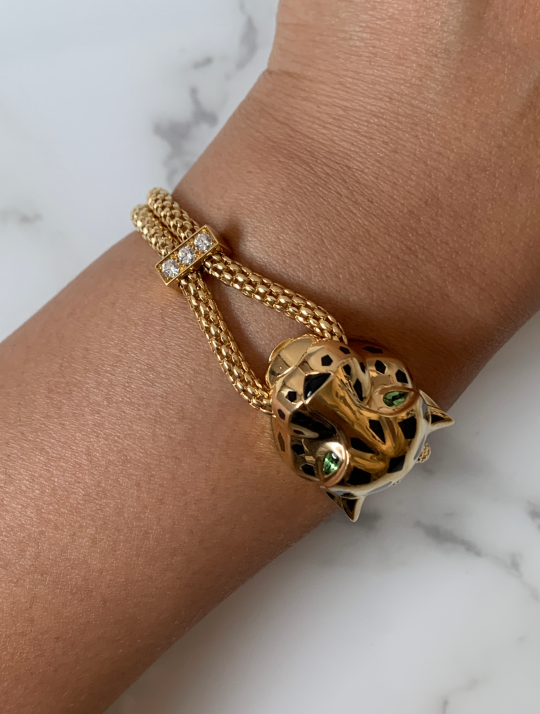VAULT 101
Cartier Bracelets: A History
By The Rebag Team, Aug. 4, 2023

Timeless Designs
Since 1847, French luxury jewelry and horlogerie maison Cartier has been producing incredibly iconic pieces for royal families, celebrities, and dignitaries alike. However, it was not until 1969 that their most influential designs would come to life in the form of the Love collection. Take a look at the history behind some of the brand’s most iconic bracelets.
Love Bracelet
During the 1960s, Cartier saw a transformative moment with the arrival of Aldo Cipullo, who conceived the iconic Love bracelet. Inspired by medieval chastity belts, Cipullo aimed to create enduring love symbols. The result was a tight-fitting oval bracelet, secured by screws and requiring a screwdriver for fastening, challenging to remove easily. Originally made from gold-plated sterling silver, it later transitioned to 18K gold, with a diamond-studded version emerging in 1979. This revolutionary design changed how people wore jewelry, signifying eternal commitment. Its unisex appeal was evident when Cartier gifted it to notable couples like Ali MacGraw and Steve McQueen, Elizabeth Taylor and Richard Burton, and the Duke and Duchess of Windsor. Seemingly exclusive to couples initially, the Love bracelet remains a timeless emblem of love and devotion.
Juste un Clou Bracelet
In 1970, Cipullo also created a stunning, bold bracelet resembling a curved nail. Inspired by the rebellious spirit of the era, he envisioned a design that would capture the essence of a nail transformed into a chic piece of jewelry. In 1971, the Juste un Clou (French for “Just a Nail”) collection was launched, featuring the distinctive nail-shaped bracelet crafted from precious metals like gold and adorned with diamonds in some iterations. This avant-garde creation challenged conventional notions of luxury jewelry and embraced the notion of finding beauty in everyday objects. In 2012, Cartier introduced new designs to the Juste un Clou line, including thicker bracelets and wrap-around diamond rings. Today the collection also includes earrings, cufflinks, and necklaces crafted in various metals, including gold, white gold, and rose gold.
Trinity Bracelet
The Cartier Trinity bracelet traces its roots to Louis Cartier’s ingenious design of a ring in 1924. Featuring three intertwined bands of white, yellow, and rose gold, each band represents love, fidelity, and friendship, respectively. The Trinity collection emerged during the Art Deco Era, a time of lavish ornamentation, making its simple and pure design a bold statement. The collection expanded to include earrings, necklaces, and variations with pavé diamonds, colored stones, pearls, and gold hearts. Both elegant and technically remarkable, the Trinity bracelets effortlessly slide over the skin.
Panthère de Cartier Bracelet
Jeanne Toussaint, who took charge of Cartier’s jewelry department in 1933, is to be thanked for one of Cartier’s most easily-recognizable motifs. Departing from abstract Art Deco designs, Toussaint embraced a more realistic approach, giving rise to the iconic ‘Great Cats,’ with the panther as the standout symbol. Adorning the wrists of esteemed figures like the Duchess of Windsor and Barbarah Hutton, the panther’s graceful form lent itself perfectly to jewelry design. With the aid of designer Peter Lemarchand, Toussaint brought her vision of three-dimensional panther creations to life. In 1948, the Duchess of Windsor received the first three-dimensional Cartier Panthère bracelet, featuring a stunning 116.74-carat emerald from the Duke’s collection, elegantly perched above the panther. This significant moment marked the beginning of a lasting legacy, as Cartier continues to incorporate the majestic ‘Big Cat’ theme into their timeless designs.
